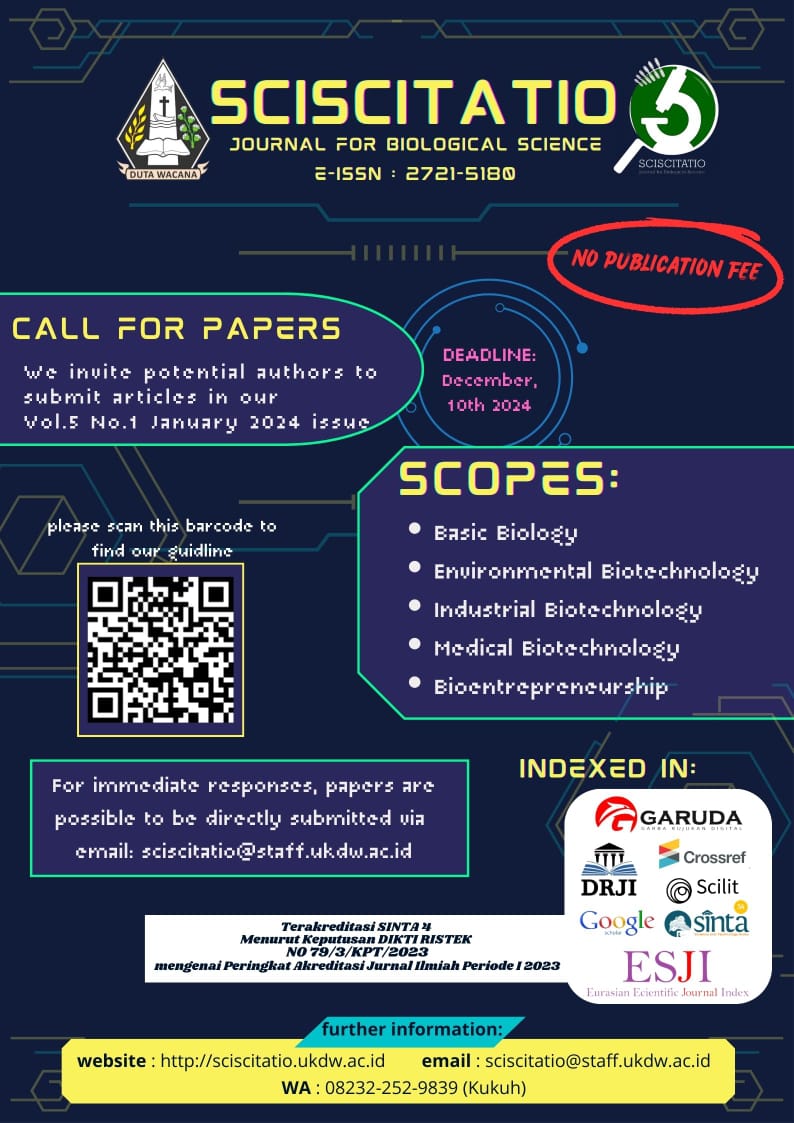Potency of Citrus reticulata Peel Extract as Active Compound of NonAlcohol Based Gel Hand Sanitizer
DOI:
https://doi.org/10.21460/sciscitatio.2020.12.32Keywords:
Citrus reticulata, extracts, antimicrobial, Staphylococcus aureus, hand sanitizer.Abstract
Hand sanitizer is nowadays known as a part of one’s personal hygiene kit because of its practical use and
effectivity against skin microbes, such as Staphylococcus aureus. The common commercial hand sanitizers are made
from alcohol which may have negative side effect like skin irritation. Utilization of active compounds from a plant
that has antibacterial compounds might be applied to the substitution of alcohol in the formulation of hand sanitizer.
In this study, phytochemical compounds from Citrus reticulata and Citrus aurantifolia peel extracts were tested
qualitatively and their antibacterial acitivity on Staphylococcus aureus were tested using disk diffusion method. The
results showed that Citrus reticulata peel extract at the concentration of 70% was the most effective concentration in
inhibiting Staphylococcus aureus. This certain concentration of Citrus reticulata peel extract was then chosen in the gel
hand sanitizer formulation. Application of gel hand sanitizer with Citrus reticulata peel extract as its active compound
on the hands of respondents were also observed to inhibit bacterial growth. The use of peel extracts from Citrus
spp, especially from Citrus reticulata might be potential in the formulation of non-alcohol based gel hand sanitizer.
References
Ahmed, B. (2007). Chemistry Of Natural Products. New Delhi: Department of Pharmaceutical Chemistry Faculty of Science Jamia Hamdard.
Ayoola, G. A., Johnson, O. O., Adelowotan, Aibinu, I. E., Adenipekun, E., AdepojuBello, A. A., Coker, H. A., & Odugbemi, T. O. (2008). Evaluation of the chemical constituents and the antimicrobial activity of thevolatile oil of Citrus reticulata fruit (Tangerine fruit peel) from South WestNigeria, African Journal of Biotechnology, 7(13), 2227-2231.
Brooks, G.F., Carroll, K., & Butel, J. S. (2013). Jawetz, Melnick, & Adelberg`s Medical Microbiology 26thed.McGraw-Hill Company Inc,Philadelphia.
Choi, S. Y., Ko, H. C., Ko, S. Y., Hwang, J. H., Park, J. G., Kang, S. H., Han, S. H., Yun, S. H, & Kim, S. J. (2007). Correlation between flavonoid content and the no production inhibitory activity of peel extracts from various Citrus fruits, Biological and Pharmaceutical Bulletin, 30(4), 772-800
Darsana, I., Besung, I., & Mahatmi, H. (2012). Potensi Daun Binahong (Anredera cordifolia (Tenore), Steenis) dalam menghambat Pertumbuhan Bakteri Escherichia coli secara In vitro. Indonesia Medicus Veterinus.
Ergina., Nuryanti, S., & Pursitasari, I. D. (2014). Uji Kualitatif Senyawa Metabolit Sekunder Pada Daun Palado (Agave Angustifolia) Yang Diekstraksi Dengan Pelarut Air Dan Etanol. Jurnal Akademika Kimia, 3(3), 165-172.
Faozi, G. (2013). Efektivitas Ekstrak Etanol Biji Pinang (Areca catechu L.) Terhadap bakteri Aeromonas hydrophila Secara In-Vitro [skripsi]. Fakultas Keguruan dan Ilmu Pendidikan Universitas Muhammadiyah, Purwokerto.
Garg, A., Aggarwal, D., Garg, S., & Sigla, A.K. (2002). Spreading of Semisolid Formulation: An Update, Pharmaceutical Technology.
Harborne, J. B. (1987). Metode Fitokimia Penuntun Cara Modern Menganalisis Tumbuhan. Penerbit ITB, Bandung.
Hasnaeni, H & Wisdawati, W. (2019). Pengaruh Metode Ekstraksi Terhadap Rendemen Dan Kadar Fenolik Ekstrak Tanaman Kayu Beta-Beta (Lunasia amara Blanco), Jurnal Farmasi Galenika (Galenika Journal of Pharmacy), 5(2), 175-182.
Jasim, A. R. (2012). Phytochemical Study of some Flavonoids Present in the Fruit Peels of Citrus reticulata Grown in Iraq. Department of pharmacognosy, College of Pharmacy, University of Baghdad, Baghdad, Iraq. Kerbala journal of pharmaceutical Sciences Number 3, 136-151.
Kurniawan, D. W., Wijayanto, B. A., & Sobri, I. (2012). Formulation and Effectiveness of Antiseptic Hand Gel Preparations Essential Oils Galanga (Alpinia galanga), Asian Journal of Pharmaceutical, Biological, and Chemical Science, 2(4).
Lauma, S.W., Pangemanan, D.H.C, & Hutugalung, B. S. P. (2015). Uji Efektifitas Perasan Air Jeruk Nipis (Citrus
Aurantifolia S) Terhadap Pertumbuhan Bakteri Staphylococcus aureus Secara In Vitro. Pharmacon Jurnal Ilmiah Farmasi, 4(4), 9-15.
Nuria, M. C & Faizaitun, A. S. (2009). Uji Aktivitas Antibakteri Ekstrak Etanol Daun Jarak Pagar (Jatropha curcas, L.) terhadap Bakteri Staphylococcus aureus ATCC 25923, Escherichia coli ATCC 25922, dan Salmonella typhi ATCC 1408, Mediagro, 5(2), 26-37.
Pelczar, M. J & Chan, E. S. (1988). Dasar dasar Mikrobiologi Edisi ke-2. Penerbit Universitas Indonesia, Jakarta.
Rahmi, Y., Darmawi, Mahdi, A., Faisal, J., & Fakhrurrazi, Y. F. (2015). Identification of Staphylococcus aureus in preputium and vagina of horse (Equus caballus). Journal Medika Veterinaria, 9(2), 15-158.
Schiff, G.D., Galanter, W.L., Duhig, J., Koronkowski, M., Lodolce, A. E., Pontikes, P., Busker, J., Touchette, D., Walton, S., & Lambert, B. L. (2012). A Prescription for Improving Drug Formulary Decision Making, PLoS Medicine, 9(5),e1001220. doi:10.1371/journal.pmed.1001220
SNI 06-2588-1992. (1992). Sabun Cair Pembersih Tangan. Badan Standardisasi Nasional,Jakarta.


